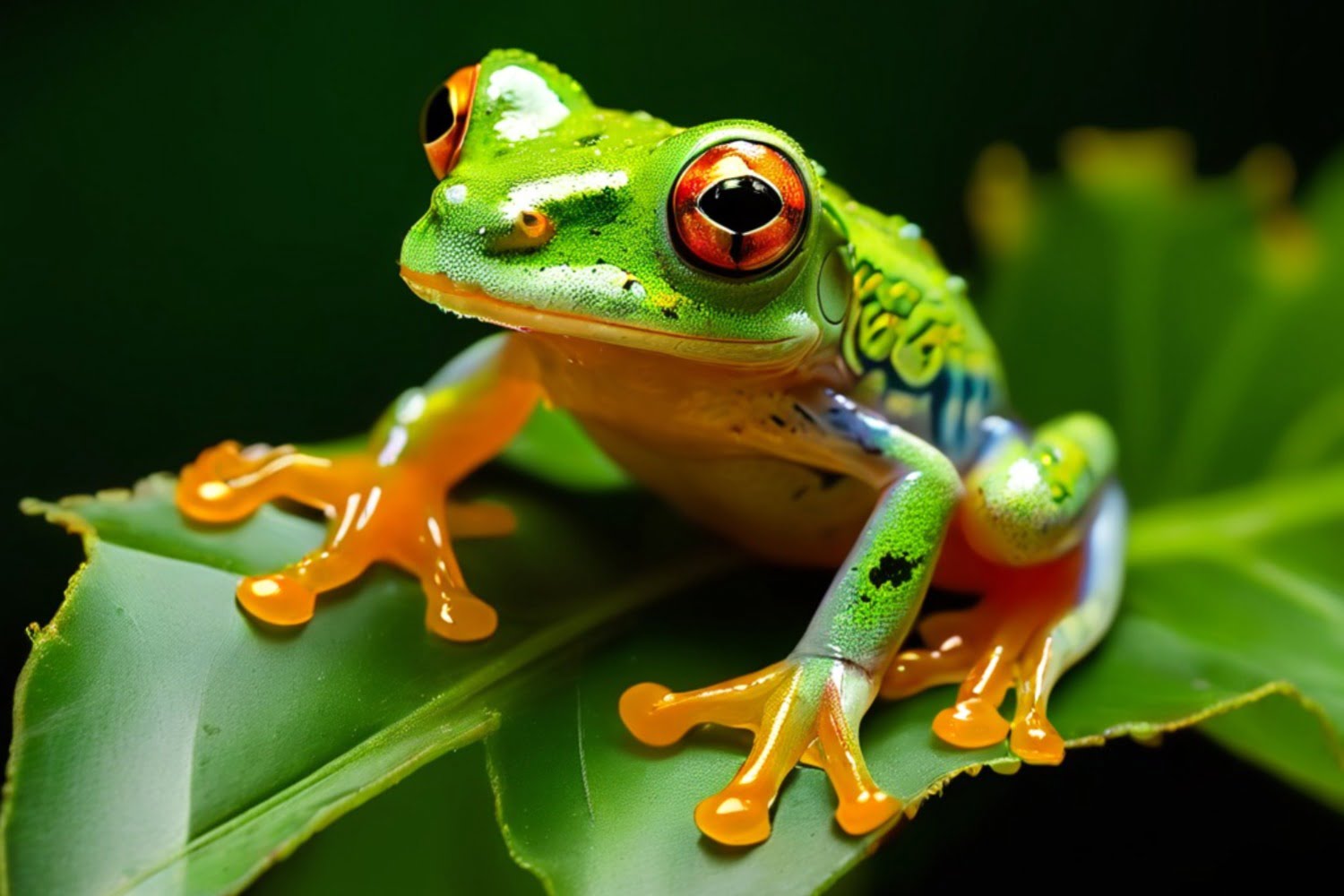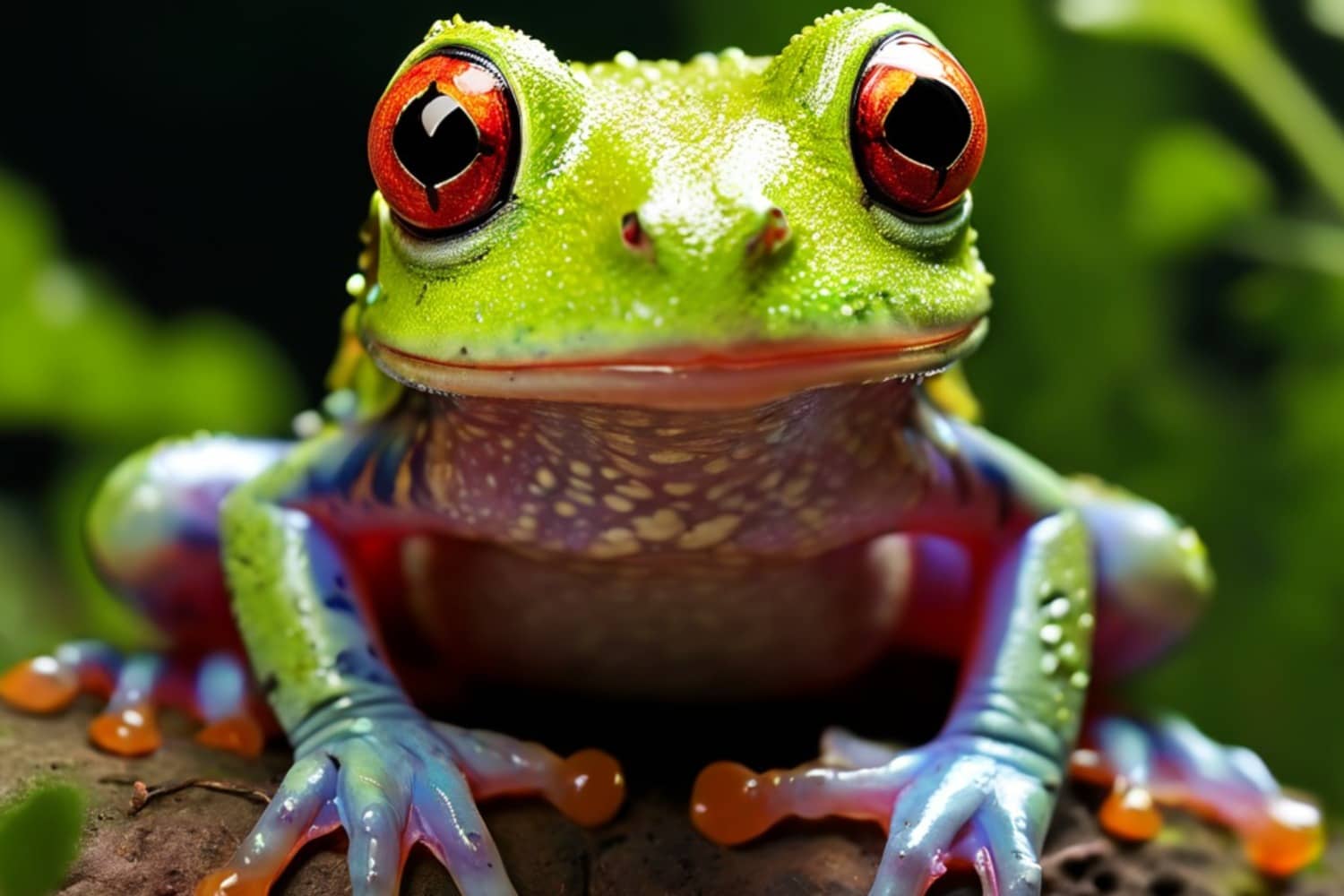7 Magnificent Glass Frog Species of the Tropics: Unveiling Beauty, Diversity, and Threats
Imagine peering into the emerald embrace of a Central or South American rainforest. Sunlight filters through the dense canopy, dappling the lush foliage with vibrant light. Amongst the leaves, a tiny emerald jewel catches your eye. It is a remarkable amphibian glass frog species famed for its translucent skin that reveals its internal organs!
Glass frogs are just one example of the incredible diversity found among tropical frog species. These remarkable creatures come in various shapes, sizes, and colors, each playing a vital role in the rainforest ecosystem. This comprehensive guide will delve into the fascinating world of glass frogs and explore some of their most captivating rainforest neighbors.
Key Takeaways
- Glass frogs are remarkable amphibians found in Central and South American rainforests.
- Their translucent skin provides excellent camouflage, allowing them to blend in with leaves.
- These tiny insectivores are not poisonous but face habitat loss and climate change threats.
- Conservation efforts and responsible choices can help ensure their survival.
Spotlight on Transparency: The Glass Frog

The glass frog (Centrolenidae family) is a true marvel of evolution. Its ventral (underside) skin is incredibly thin and transparent, allowing you to see its heart, liver, and even intestines in some species. This transparency serves a clever purpose—camouflage. By blending seamlessly with leaves, the glass frog practically disappears, offering protection from predators like snakes and birds.
However, wait, there is more! When a glass frog is inactive, its blood gathers in its liver, making it even less visible. However, blood flow increases throughout the body when active, causing the frog to appear slightly greenish or yellowish. This fascinating adaptation highlights the ingenious ways these tiny amphibians survive in the rainforest.
Beyond transparency, glass frogs are arboreal (tree-dwelling) masters. Their webbed toes provide exceptional grip on slippery leaves, allowing them to navigate the rainforest canopy easily. They are primarily nocturnal creatures, emerging at night to hunt for small insects like flies, crickets, and moths. Their mating season coincides with the rainy season, and males attract mates with loud, whistling calls.
Exploring the Rainforest Jewels: Other Fascinating Tropical Frogs

The rainforest is a treasure trove of amphibian diversity, and glass frogs share their emerald domain with various other incredible frog species. Here is a glimpse at a few:
The Red-Eyed Tree Frog (Agalychnis callidryas)

This stunning frog boasts vibrant green skin with bold red eyes. Nocturnal hunters use their sticky toe pads to stalk prey and their impressive bulging eyes to see in low-light conditions. Their loud cackling call is a familiar sound in the rainforest at night.
The Blue Poison Dart Frog (Dendrobates tinctorius)

While undeniably beautiful with its vibrant blue body and black markings, this little frog packs a powerful punch. Its skin contains toxins that can be lethal to predators, making it a prime example of aposematism (warning coloration).
The Mighty Goliath Frog (Conraua Goliath)

This gentle giant is the world’s largest frog species, reaching a whopping 13 inches (33 cm) in length and weighing up to 6.6 pounds (3 kg)! Primarily ground-dwelling, Goliath frogs feed on insects, small mammals, and other frogs. Despite their size, they are considered a threatened species due to habitat loss and the illegal pet trade.
Comparison of Rainforest Frog Species
| Feature | Glass Frog | Red-Eyed Tree Frog | Blue Poison Dart Frog | Goliath Frog |
|---|---|---|---|---|
| Transparency | Yes (ventral skin) | No | No | No |
| Size | Tiny (0.7-1.2 inches) | Medium (2-4 inches) | Tiny (0.7-1.2 inches) | Large (up to 13 inches) |
| Coloration | Lime green (transparent underside) | Green with red eyes | Blue with black markings | Brownish-gray |
| Habitat | Rainforest canopy | Rainforest canopy | Rainforest floor | Rainforest floor |
| Diet | Small insects | Insects, small vertebrates | Insects | Insects, small mammals, and other frogs |
Please note: This table is just a tiny sample of the incredible diversity of rainforest frog species. There are hundreds of unique species, each with fascinating characteristics and adaptations.
A Paradise Under Threat: Challenges Faced by Tropical Frogs

Tropical frogs, including glass frogs, face a multitude of threats. Habitat loss due to deforestation for agriculture, logging, and mining is a major concern. The destruction of rainforests destroys their homes and disrupts the delicate balance of the ecosystem they depend on.
Climate change is another significant threat. Rising temperatures and changes in precipitation patterns can have a devastating impact on frog populations. Amphibians are susceptible to environmental changes, and their permeable skin makes them especially vulnerable to dehydration caused by drier conditions. Additionally, climate changes can disrupt breeding cycles and food availability.
The illegal pet trade is another pressing issue. Exotic pet collectors prize some frog species, including some glass frog varieties. This demand fuels the illegal capture and trade of these amphibians, often leading to overcrowding, stress, and death in captivity.
The combined effects of habitat loss, climate change, and the pet trade have endangered many frog species.
Protecting the Rainforest Symphony: Conservation Efforts

Fortunately, there is hope. Conservation organizations worldwide are working tirelessly to protect these remarkable creatures. Here are some critical efforts:
- Habitat Protection: Organizations are working to establish protected areas and promote sustainable forestry practices to preserve rainforest habitats.
- Captive Breeding Programs: Breeding programs aim to create healthy populations of threatened frog species in controlled environments. These frogs can then be reintroduced into the wild when conditions are suitable.
- Education and Awareness: It is crucial to raise public awareness about the importance of frogs and the threats they face. Educational programs encourage individuals and communities to support conservation efforts.
How You Can Help Preserve These Amphibians:
Even small actions can make a big difference in the future of glass frogs and other rainforest amphibians. Here is what you can do:
- Support Conservation Organizations: Donate to or volunteer with organizations that protect rainforests and their inhabitants.
- Reduce Your Environmental Impact: To help mitigate climate change, minimize your carbon footprint. This can involve reducing energy consumption, using sustainable products, and supporting deforestation-free businesses.
- Spread Awareness: Talk to friends and family about the importance of rainforest conservation and the threats amphibians face.
- Choose Sustainable Products: Look for products certified by organizations like the Rainforest Alliance that promote sustainable practices.
- Avoid Exotic Pets: Do not buy exotic pets, especially wild-caught ones. If you’re interested in keeping frogs as pets, support ethical breeders of domestic species.
By working together, we can ensure that the vibrant symphony of frog calls continues to echo through the rainforests for generations.
Conclusion
The future of glass frogs and other tropical amphibians rests on our shoulders. By understanding the threats they face and supporting conservation efforts, we can ensure these fascinating creatures continue to thrive in their emerald paradise.
These remarkable amphibians add beauty and biodiversity to the rainforest ecosystem and play a vital role in pest control and nutrient cycling. Protecting them is crucial for maintaining the overall health of rainforests and, ultimately, the health of our planet.
Frequently Asked Questions
Where do glass frog species live?
Glass frog species are primarily found in the humid rainforests of Central and South America, with some inhabiting regions stretching from Mexico down to Panama. They thrive in the warm, wet climate and abundant vegetation these rainforests offer.
How many glass frog species are there?
The exact number of glass frog species is still being discovered! As of 2024, over 160 recognized species are classified within the Centrolenidae family. New species are being discovered frequently, highlighting the incredible biodiversity of these rainforest amphibians.
Are glass frog species poisonous?
Thankfully, glass frogs themselves are not poisonous. They rely on their remarkable camouflage abilities to stay hidden from predators. However, some rainforest frog species, like the brightly colored dart frogs, possess toxins as a defense mechanism.
What do glass frog species eat?
Glass frogs are insectivores that feast on small insects like flies, crickets, and moths. Their sharp eyesight and sticky toe pads make them excellent hunters, allowing them to snatch prey with impressive agility.
What is the rarest glass frog species?
Due to ongoing habitat loss and the secretive nature of these amphibians, pinpointing the absolute rarest glass frog species is challenging. However, some species, like the La Tigra Glass Frog (Hyalinobatrachium tiguanum) and the Bare-hearted Glass Frog (Hyalinobatrachium valerioi), are classified as critically endangered by the IUCN due to their limited habitat range and population decline.
Can you keep glass frog species as pets?
In general, keeping glass frog species as pets is not recommended. These delicate amphibians have specific environmental requirements that are difficult to replicate in captivity. They are susceptible to stress and require specialized care to thrive. Additionally, the capture and trade of wild glass frogs can contribute to population decline. If you want to keep frogs as pets, consider researching more readily available and hardier species that can be ethically bred in captivity.
How big are glass frog species?
Glass frogs are some of the tiniest frog species in the world! Most species range from a mere 0.7 to 1.2 inches (18–30 mm) in length. Their small size makes them adept at navigating the rainforest canopy and hiding amongst leaves.
What is the lifecycle of glass frog species?
Glass frogs reproduce during the rainy season. Males attract mates with loud calls, and females lay their eggs on the underside of leaves overhanging water sources. After hatching, the tadpoles develop into adult frogs in the water before undergoing metamorphosis.
Are glass frog species endangered?
Habitat loss due to deforestation and climate change significantly threatens many glass frog species. The delicate balance of the rainforest ecosystem is crucial for their survival. Thankfully, conservation efforts are underway to protect these fascinating amphibians and their rainforest homes.
How do glass frog species camouflage themselves?
The most remarkable characteristic of glass frogs is their translucent skin, which allows them to blend seamlessly with leaves. Their blood pools in the liver, making them even more transparent when inactive. This remarkable adaptation provides them with exceptional camouflage against predators like birds and snakes.







